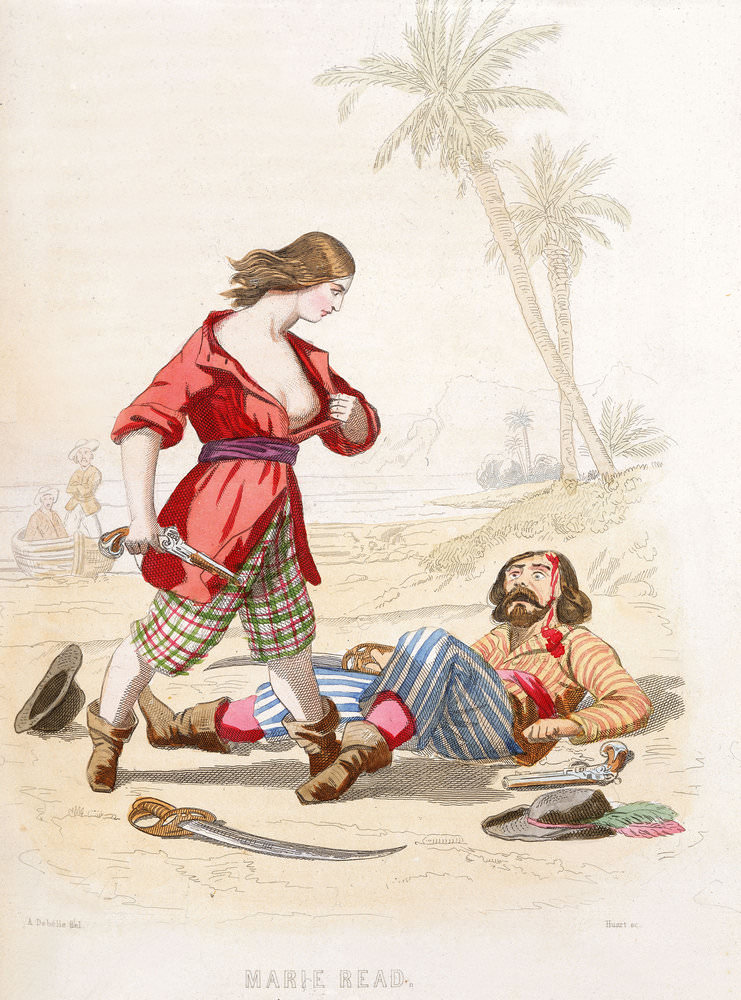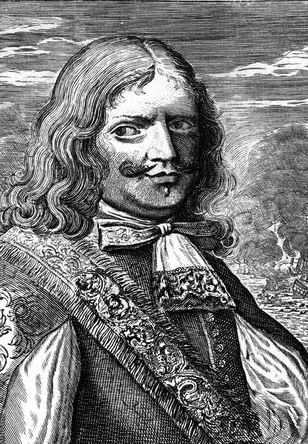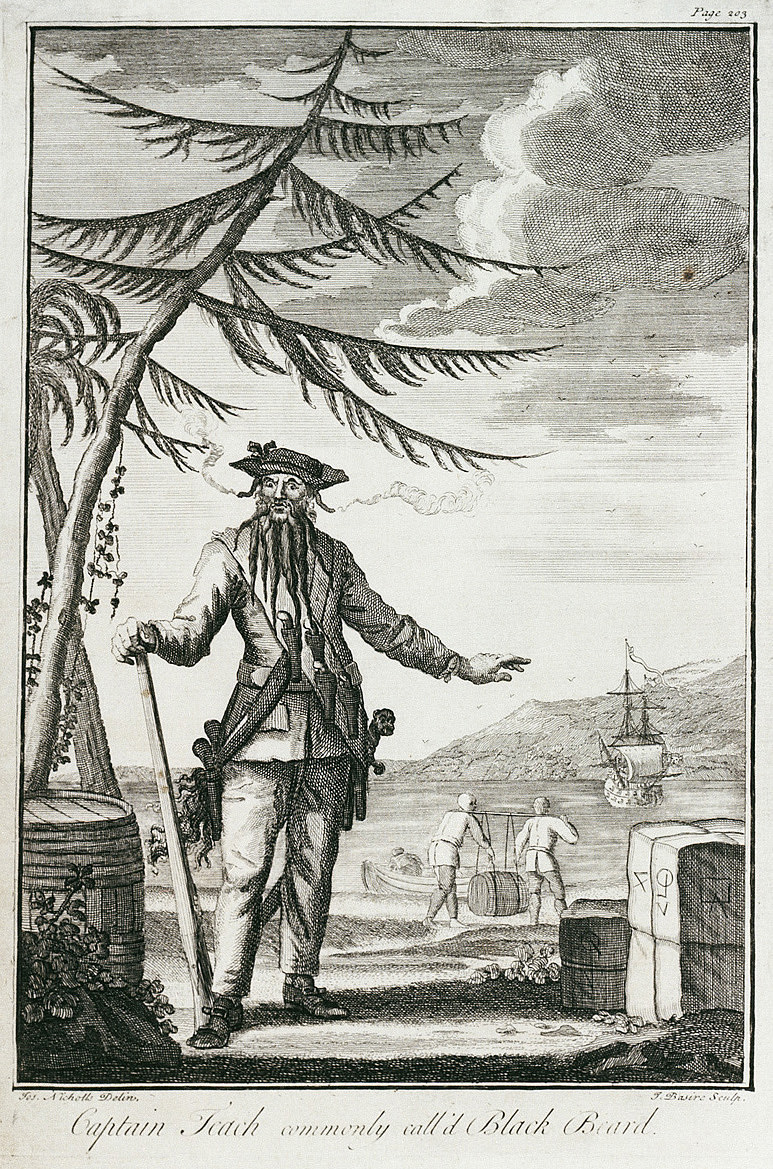What we admire in pirates—at least our fictional pirates—is that they so enjoy their villainy. They’re not sly or covert or subtle. Everything about them is over-the-top, histrionic: they glory in their infamy. While most of us drag ourselves through the daily dullness of our lives, they swagger, they pirouette, and, in the case of Captain Hook, even dance a tarantella. Like the trailblazer and the gunslinger, the pirate represents a New World ideal of freedom—a proud renegade living by his wits and his daring.
Of course, pirates were historically crude, vicious, and bloodthirsty—qualities that the two recent TV series Black Sails and Crossbones have certainly dramatized (or melodramatized). Neither show is particularly remarkable—Crossbones, which starred John Malkovich as Blackbeard living in hiding from the British Navy, has since been cancelled after only one season, and Black Sails, a historical drama devised as a prequel to Robert Louis Stevenson’s Treasure Island, is mostly an aimless welter of sex and violence.
By contrast, the pirates of our older films and literature seem like nautical Robin Hoods or bold robber knights. Pirate captains, in particular, have often been portrayed as models of courtesy and grace. James Hook attended Eton and Balliol (and, J.M. Barrie tells us, was fond of “poetry of the Lakeland School”); Rafael Sabatini’s fierce corsair Sakr-el-Bahr—the Sea-Hawk, in the 1935 novel of the same name—is actually the Cornish nobleman Sir Oliver Tresillian. Even Long John Silver acts, in many ways, as a kindly foster father to Jim Hawkins, who is pleased that the one-legged scoundrel manages to escape at the end of Treasure Island.
Many of these proud buccaneers exhibit a dandy’s taste for elegant finery. The standard garb—earrings and sashes, as well as lace at the wrists and feathers in often elaborate hats—actually lends a distinctly femininizing air to their appearance, while the widespread practice of swinging on sail-lines or capering on crossbeams suggests the circus or the ballet. Pirate captains are obviously the Baryshnikovs of the sea lanes.
Many are also distinctly camp. The first pirate most of us encounter is Captain Hook, who, as played by Cyril Ritchard in the Mary Martin version of Peter Pan, glories in the mincing affectation and extravagance of a boisterous drag queen (there were, in fact, cross-dressing female pirates, like Mary Read and Anne Bonny). Johnny Depp as the bejeweled Jack Sparrow continues this tradition, as did, in a more wholesome manner, Burt Lancaster, who portrayed The Crimson Pirate in the film of that name with uncontainable exuberance and a smile as big as a mainsail. Think, too, of Wesley, played by Carey Elwes, as the almost foppish Dread Pirate Roberts in The Princess Bride. Such figures aren’t villains; they are self-aware performance artists. Being stagey and colorful is their life.
This is true even of real pirates. Consider Edward Teach, aka Blackbeard, as described by Charles Johnson in A General History of the Pyrates, first published in 1724:
This beard was black, which he suffered to grow of an extravagant length; as to breadth, it came up to his eyes; he was accustomed to twist it with ribbons, in small tails, after the manner of our Ramilies wigs, and turn them about his ears: in time of action, he wore a sling over his shoulders, with three brace of pistols, hanging in holsters like bandoliers, and stuck lighted matches under his hat, which appearing on each side of his face, his eyes naturally looking fierce and wild, made him altogether such a figure that imagination cannot form an idea of a fury, from Hell, to look more frightful.
Our literary fascination with pirates dates back centuries. Alexander Exquemelin’s best-selling Buccaneers of America, a history that described itself as “A true account of the most remarkable assaults committed of late years upon the coasts of West Indies by the Buccaneers of Jamaica and Tortuga,” was first published in Dutch in 1678, and in English in 1684. Since then, a staggering number of novels, histories, and poems about pirates have followed, including Byron’s romantic 1814 poem The Corsair (which sold 10,000 copies on the day of publication); Arthur Conan Doyle’s The Dealings of Captain Sharkey (1919), a series of sometimes gruesome short stories about the ruthless Sharkey and his ship The Happy Delivery; Ruth Plumly Thompson’s light-hearted Pirates in Oz (1931); and Richard Hughes’s A High Wind in Jamaica (1929), the tale of five English children kidnapped by pirates (who, it turns out, are mere innocents abroad compared to cruel and heartless schoolchildren). Our greatest comic novel about sea-roving villains and swashbucklers is George MacDonald Fraser’s The Pyrates (1983), inimitably bawdy, thrilling, and deliciously tongue-in-cheek. One would expect no less from the editor of The Flashman Papers.
Advertisement
My own favorite book about real pirates is The Sack of Panama: Sir Henry Morgan’s Adventures on the Spanish Main, by Peter Earle, first published in 1982. In five years of privateering during the late 1660s Morgan managed to carry out the most successful amphibious raid of the seventeenth century (the capture in a single morning of the entire city of Portobello), to pierce a seemingly impregnable naval blockade across the freshwater straits of the Laguna de Maracaibo (he sacrificed his largest vessel as a fireship), and to sack the rich city of Panama. To accomplish this last he force-marched his men through the jungle for days, risking starvation. When his ragtag mercenaries finally emerged from the tropical undergrowth, they were confronted by extensive cavalry, a dedicated general, and a desperate city. Not good odds, it would seem. But, as Peter Earle demonstrates in his thrilling book, the Spanish never had a chance.
Some of Morgan’s exploits would later be attributed to Peter Blood, the hero of what is still the most rousing of all pirate novels, Rafael Sabatini’s Captain Blood (1922). In this blend of Alexander Dumas-like adventure, moral tale, and romantic love story a seventeenth-century physician wrongly convicted of treason escapes from slavery to transform himself into the most feared of all the “brethren of the coast.” If you’ve only seen the superbly swashbuckling 1935 movie starring Errol Flynn, you really should track down the even more wonderful book itself.





